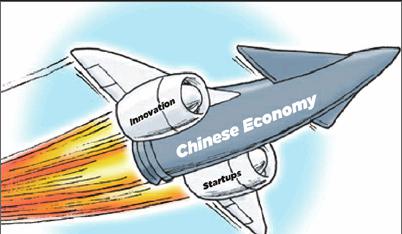Wanted:Innovation
2015-09-02ByWangJun
By+Wang+Jun

In Shanghai Zhangjiang Hi-Tech Park, Teambition, a startup company that offers enterprise cloud services, has seen its sales revenue soaring 30 times in a little over a year. Its major clients include state-owned oil giants China National Petroleum Corp. and China Petrochemical Corp. as well as NYSE-listed New Oriental Education and Technology Group Inc.
When the company was established, a venture capital (VC) fund of 4.5 million yuan($735,300) helped it out of difficulty. The fund was from VC firm Gobi Partners. Zhu Lin, a partner of the firm, told Xinhua News Agency that the 350-million-yuan ($57.19 million) Gobi Yingzhi Fund set up three years ago mainly targets startup businesses in emerging sectors such as the Internet, smart hardware and lifestyle. Teambition is one of over 30 projects in which the fund has invested.
However, a fact not widely known is that of the 350-million-yuan investment fund, money from the central and municipal governments accounts for 40 percent.
How can state funds support innovation and emerging industries? With the old model, enterprises reported innovation projects to related ministries and commissions of the Central Government, which invited officials and scholars for an assessment and selected some of the projects for financial support. Without a clear definition of rights and obligations and unfair assessment procedures, a large amount of money was invested with no satisfactory results.
But things are now changing, with a new operation pattern for state funds being introduced.
Government funded
The Gobi Yingzhi Fund is one of hundreds of innovation investment funds set up by the Chinese Government. In 2007, the Ministry of Finance (MOF) and the National Development and Reform Commission (NDRC) decided to provide a portion of funds as VC funds for the research and development of national industrial technologies.
Through an open bid, these funds are entrusted to management institutions and then invested in VC funds. The governmentled VC funds will also attract private funds to invest in strategic emerging industries. According to a Xinhua News Agency report, by the end of 2014, state funds had been involved in 213 VC funds, which had completed a total investment of 13.8 billion yuan($2.25 billion) in 739 projects.
State-owned SDIC High-Tech Investment Co. Ltd., a subsidiary of the State Development and Investment Corp. (SDIC), is managing 5.4 billion yuan ($882.35 million) of state funds, participating in 108 VC funds and raising a total amount of 30.41 billion yuan ($4.97 billion) in local government funds and private capital, Hao Jian, Chairman of SDIC High-Tech Investment Co. Ltd., told Xinhua News Agency.
“In each VC fund, the state funds invest 50 million yuan ($8.17 million), accounting for no more than 20 percent. Local governments invest an amount no less than that of the state funds, and the rest are made by private investors,” said Liu Wei, Deputy General Manager of SDIC High-Tech Investment Co. Ltd.
Where are these funds being used? Hao said the funds his company manages mainly invest in projects related to new-generation information technology, biopharmaceuticals, new materials, energy-saving and environmental protection, and high-end equipment manufacturing. Ninety percent of the investments have gone into national strategic emerging industries.
The State-Owned Assets Supervision and Administration Commission (SASAC), SDICs supervisor, is also preparing to establish one to three innovation investment funds for central state-owned enterprises (SOEs) with the aim of diversifying investment channels for them and facilitating the commercial use of innovations, according to a report from Economic Information Daily.
Li Jin, chief researcher at the China Institute of Enterprises, told Economic Information Daily that establishment of state-level funds will provide financial support for central SOEs to set up their own funds, hence accelerating the commercial use of technological achievements. Key industries that can generate more economic benefits, easily form an industrial chain and are competitive in the world market, such as equipment manufacturing, will be the first to get support from the innovation funds.
Market-oriented operations
The way government-funded VC invests in innovation and startup businesses is marketoriented. Take SDIC High-Tech Investment Co. Ltd. as an example. It is very prudent in selecting the VC it will invest in. Once a VC firm is selected, it will fully respect the professional institution when it makes its investments. “What projects to invest in and when to make the investment are both decided by the VC firm. We will not interfere,” said Zhu.
With the management of professional firms, state funds can be better used to invest in projects and companies with real advantages and growth potential. As a result, these funds have supported a number of innovative and prospective startup projects involving high technology.
Shanghai-based Cenova Ventures, another VC firm SDIC High-Tech Investment Co. Ltd. has participated in, is dedicated to pharmaceuticals, biotechnology, medical de- vices, diagnostics and healthcare services. It now manages 300 million yuan ($49 million) of VC.
“We have invested in some projects from the time that they were merely ideas,” said Wu Jun, President of Cenova Ventures. With long-time dedication in biopharmaceutical technology and medical devices, he is an expert at detecting opportunities from startup projects.
With the investment of state funds, Cenovas 300-million-yuan VC has invested in 11 projects. On average, values of these investments have increased threefold. For instance, Cenova invested 30 million yuan ($4.9 million) in a startup business producing endoscopes for medical use. A few years later, the companys market value has surpassed 1 billion yuan ($163.4 million).
Venture capitalists nurtured
A long-term benefit of market-oriented operations of state funds is that China gets the opportunity to nurture a group of venture capitalists with a professional vision.
Take Wu as an example. Returning from overseas 20 years ago, the medical expert was once engaged in medical research, starting up medical companies and facilitating initial public offerings of medical companies in overseas markets. This has gained him rich experience in making medical venture investment.
“C o m p a r e d t o provide direct financial support, a more important detail of the operations of state funds is that a number of venture capitalist teams have been nurtured,”said Wu. In a time of difficulty when Cenova was first established, few private investors were willing to invest in medical startups because of the high risks. It is the input of state funds that brings success to this VC firm and its team.
In the Guiding Opinions on Experimenting With the Use of Venture Capital as Industrial Technology Research and Development promulgated in 2007, the MOF and the NDRC have stated the principles on VC: market-based operations, encouraging innovation, and stressing guidance and lawful management.
In January 2015, the State Council decided to create a 40-billion-yuan ($6.54 billion) VC fund to encourage innovation. A State Council statement said the governmentinitiated VC fund should eventually attract private investment. Apart from the central budget, the fund will mainly incorporate capital input by big companies, large financial institutions and other private sources.
